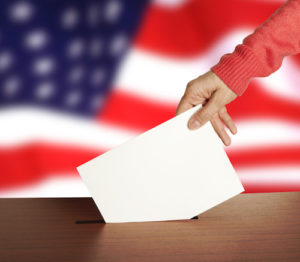Security at Polling Places in 2020

by Dr. Jennifer Hesterman, Colonel U.S. Air Force Retired, and Watermark’s Vice President of Educational Services
Every year, millions of Americans exercise their right to vote by going to a polling location in their voting district. Churches, schools and community centers will open their doors to the public in a long-held tradition, many for 13 hours or more. This is shaping up to be the most challenging election in our nation’s history with the added strain of pandemic-related issues, such as the need for social distancing, wearing of masks, and decontaminating voting machines.
Election day is not only a celebration of our democracy, but a growing security challenge. Despite the pandemic crisis, we are seeing a sharp increase in violence in our country, and people are acting out on their anger like never before. Add a contentious election cycle, with supporters emotional about their candidates, and “hot button” issues. We also have terrorist groups actively targeting our country, chatting about our domestic challenges and possibly looking for an opportunity to impact the election or, at the very least, get wide press coverage of through an attack on highly visible venues. Crowded public places which are basically unsecured, such polling centers, are the perfect target. Mass shootings are at the highest level since 2015. People are feeling stressed and acting out on their anger.
The bottom line: the pandemic didn’t cancel terrorism and violent crime. While we were quarantined, groups and bad actors were ramping up.
The report Electoral Violence: A Study of the 2016 United States Presidential Election (Araida, et al, 2016) records, analyzes, and contextualizes electoral violence in the United States during the 2016 electoral cycle. Data shows a spike of violence around the primaries, as well as on election day. Physical violence is the most prevalent type of violence during that period, followed by threats, intimidation and vandalism. Finally, as evidenced this year, rallies and protests continue to be flashpoints for violence. Therefore, host organizations must have emergency plans and security personnel in place to protect their facilities and attendees.
Many venues stay open for business during polling, mixing facility users with the voting public. As the parent of a student attending a school that will be open on election day, or the user of a facility opening its doors to both you and the voting public, you have the right to ask the vendor questions about their safety and security plan for the day. Don’t assume they have a plan or have even considered their location as a place where violence could occur. Very often, building owners have a severe blind spot about their vulnerabilities. They don’t believe violence could happen on their property, especially those in rural areas or tucked away in quiet neighborhoods, and, thus, do not adequately prepare. Security in the form of a police officer, contracted security, or even just a parked security vehicle at the location may deter those who might do harm. Since most polling locations don’t have the funds for increased security, I recommend they ask parents, parishioners, neighbors, or community members with experience in law enforcement or the military for voluntary assistance on election day. A simple solution! Access control is a must at the polling location. For instance, there should be a specific parking area for voters, separate from facility users. Parking on voting day is always chaotic with vehicles in the grass, etc. so remember that fire lanes must be kept open in case of an emergency. Cones, ropes, or even chairs will work. Also, extra traffic generated by voters is a serious issue in areas with pedestrians (for example the elderly or children), so safe walkways at the location is a must. I recommend volunteers man the parking area and adjacent crosswalks to assist with pedestrian and vehicle flow.
Finally, voters shouldn’t be able to roam all over the property of the polling place, or throughout the building. There should be one entry and one exit for the voters, preferably not the same passageway due to need for social distancing. More so than ever, there must be enough manpower at the location to ensure crowd control and to engage on issues such as mask wear. Think in terms of layered defense, layers of security and safety around the event. Engage voters far beyond the building front door.
No one wants to imagine the worst, but we must in order to properly prepare. No town, city, state or region is immune from attack. If the public is educated on risk and response, they become force multipliers to resource-constrained law enforcement in our communities. The message you send prior to voting day regarding what voters should expect at their polling location is key. Use strong language regarding the presence of security, no bags allowed inside the polling location, and so forth. Posted signage at the location will help, as well. Be on the offensive; unapologetically shape the security environment you want at the location.
The bottom line: you certainly have the right to ask the voting location or local officials about their security plan and measures before Election Day. Also, if you sense security or safety issues, unapologetically bring them to the attention of those in charge at the polling site and try to offer a solution.
Source:
Electoral Violence: A Study of the 2016 United States Presidential Election Georgetown University.
Saki Araida, Evan Chiacchiaro, Georgia Garney, Elizabeth Lievens, Sundar Ramanujam, and Laura Sinclair. https://georgetown.app.box.com/s/3u2tdmlkx3g3pnw6l040n92806svpk9d



